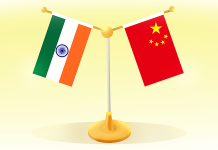In a strategic and calculated move, India has chosen not to retaliate against the recently imposed U.S. tariffs, instead focusing on pushing forward a long-pending bilateral trade deal with Washington. As the global trade climate heats up following protectionist signals from the United States, New Delhi appears committed to a path of economic diplomacy over confrontation.
In This Article:
U.S. Tariff Shockwaves: The Background
Former U.S. President Donald Trump’s return to political prominence has reignited economic protectionism, with tariff increases aimed at foreign imports, particularly from China, Mexico, and India. While the immediate economic damage from these measures is still unfolding, experts believe India is not the primary target, and any retaliatory action could prove economically counterproductive.
India’s Response — Strategic Patience Over Tit-for-Tat
Rather than imposing reciprocal tariffs, India’s trade policy is taking a measured and pragmatic approach. Sources in the Ministry of Commerce indicate that India aims to capitalize on ongoing trade negotiations instead of escalating tensions.
Key Highlights of India’s Strategy
- Avoiding hasty retaliatory tariffs to prevent disruption in U.S.-bound exports
- Reinforcing diplomatic channels to expedite a comprehensive bilateral trade deal
- Monitoring the global impact of U.S. tariffs on other major exporters
- Maintaining WTO-aligned trade positions to uphold international credibility
Economic Experts Weigh In
“Reciprocal Tariffs are Baffling”: Kaushik Basu
Renowned economist and former Chief Economic Adviser Kaushik Basu commented on the scenario, stating that “reciprocal tariffs are baffling” and may disproportionately hurt India in the current geopolitical environment.
“India should refrain from knee-jerk retaliation. The adverse impact could be significant, especially for export-reliant sectors like textiles and pharmaceuticals,” Basu emphasized.
His cautionary words reflect a broader consensus among economists that India’s current approach — de-escalation and negotiation — could yield better long-term results.
Trade Talks: India Eyes ‘Win-Win’ Deal
India has rekindled efforts to reach a bilateral trade agreement with the U.S., stalled for years due to disagreements over market access, data localization, and tariff reductions on agricultural products and tech goods.
Government officials say the goal is to unlock billions in bilateral trade, particularly in sectors like defense, clean energy, digital services, and pharmaceuticals.
Why a Trade Deal Makes Sense for India
- Improves access to U.S. markets for Indian exporters
- Avoids friction over digital taxation and e-commerce regulation
- Builds trust in the post-pandemic economic order
- Counters China’s influence in global trade partnerships
Global Context: Who’s Really Affected by U.S. Tariffs?
Interestingly, many experts believe that India is not the primary target of the U.S. tariffs — instead, the brunt is likely to be borne by China and Mexico, whose export volumes to the U.S. are substantially higher.
According to a report, India may even gain competitive advantage in select product categories if Chinese goods become more expensive in the U.S. due to the tariffs.
Political Implications: Modi Government’s Calculated Gamble
Analysts suggest that the Modi government’s restraint is also politically motivated. With general elections approaching in 2026, a trade disruption could negatively impact key constituencies — especially export-driven states.
By focusing on constructive engagement with the U.S., India also reinforces its status as a responsible global power, contrasting itself with more combative international players.
No Retaliation — But Not Passive Either
While India avoids direct retaliation, it isn’t taking a back seat. The government is:
- Expanding trade with EU, ASEAN, and Africa to diversify dependency
- Fast-tracking production-linked incentives (PLIs) to enhance export competitiveness
- Strengthening its case at WTO on unfair trade practices and overreach in tariff policies
This multi-layered approach highlights that while India avoids a tariff war, it is actively fortifying its trade ecosystem against future shocks.
Moving Forward — Trade Over Tension
India’s refusal to retaliate against U.S. tariffs isn’t a sign of weakness — it’s a well-thought-out economic strategy. With a potential trade deal on the horizon and export opportunities rising due to global tariff shifts, India may end up turning this diplomatic balancing act into an economic advantage.
In a world increasingly leaning toward economic nationalism, India’s mature, measured approach could set a precedent for how emerging economies engage with superpowers.
By – Nikita




